Yaha is located in the northern mountainous region of Tigray. However today this small settlement exists as a shanty town, it was once of a great pre-Axumite civilization and it is believed to be Ethiopia’s first capital. Yaha was first uncovered in a complex archeological excavation around a courtyard at the beginning of the 20th century. The first settlers of this area, the Sabian, where the founder of the Axumite kingdom. The temple of yaha, with one side of its walls in ruin, is otherwise still intact and shows to the advanced of the people of those time. There is no trace of mortar being used to build the temple of which the inside of the wall was believed to be have paved with Gold. The archeological excavation made in 1909,1947 and 1973 respectively reveal that this beautiful temple was destroyed by fire. Treasures such as Gold ring, golden lions, stone carved animals like the waliya ibex (one of Ethiopian endemic mammal), pottery works and others were uncovered. some of these findings are displayed at national museum in Addis Ababa.
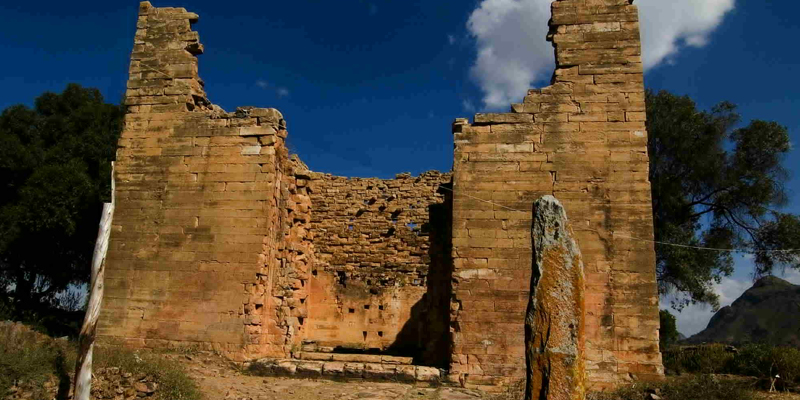
Axum is the oldest capital city in the hitroy of Ethiopia, is belived to be founded by the fabulous Queen, queen of Sheba (known as makda or Ngste Azeb) befor three thoused years. The kingdom of Axum coverd a very vast teritories which includes the presnt day of Eritera, Yemen, North east part of Sudan(Nubia) and to the south up to the Blue Nile gorge. It also regularly entered the politics of the kingdoms on the Arabian Peninsula, and eventually extended its rule over the region with the conquest of the Himyarite Kingdom in Yemen.
During this time, they had also a famous harbor at red sea called Adulis through which they could enable to controle the luckative trade rute that connect between middle east and far east. As the result of this, Axum became one of the fourth wealthiest and powerful state in the ancient world next to Persia, Rome and china. The Empire of Aksum was one of the first African polities economically and politically ambitious enough to issue its own coins from gold, siliver and bronze, which bore legends in Ge'ez and Greek. The Axumite kings erected a huge monolethic granite stelaes and witness of their unbeatable power. These stone towers served to mark graves and represent a magnificent multi-storied palace. They are decorated with false doors and windows in typical Aksumite design.
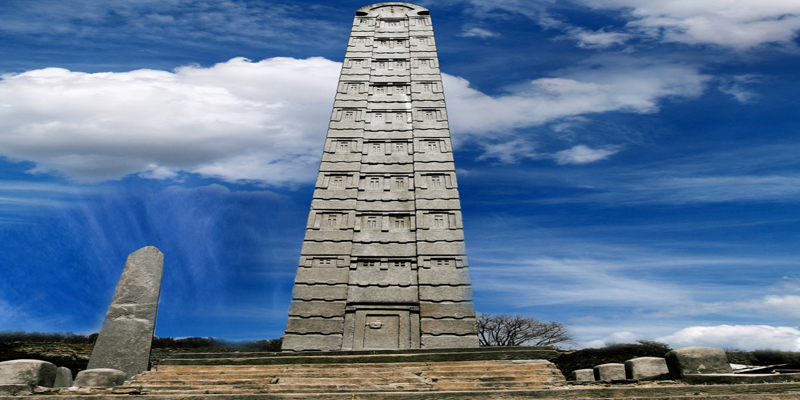
Axum’s greatest significance, however, is as the epicenter of the queen of Sheba’s dynasty, upon which rests the notion of the sacred kinship of the Semitic peoples of Ethiopian – a notion that links the recent past to ancient times. According to Kibre Negest (Glory of the King), queen of shaba gave a birth from king Solomon called Minilik l. Later he became the founder of the solomonic dynasty after his Father name king Solomon and many rulers succeeded one after the other for about 3000 years up to 1974. The former Emperor Haile Selassie claimed to the 225th monarch of the solomonic line. His death in 1975 marked the end of an era – and the beginning of the end of an entire way of life.
Many remarkable monuments here attest to the great antiquity of religious expression in this country, and as a former capital that has never lost its special appeal to the hearts and minds of all Ethiopians. It is claimed by the Ethiopian Orthodox Church that the Ark of the Covenant, in which the Ten Commandments lie, is held in the Church of st. Mary of Zion after king minilik I. brought from isreal. Axum, beside to its birth place of Ethiopian civilization, chrstianity was also introduced to Ethioppia during the time of Axum in 333 AD and became Christianity as an officialy state religion. This event makes Ethiopia the second oldest chirstian state in the world next to Armen. However, according to the holy Bible (Act 8:26) Christianity was introduced to Ethiopia even much earlier than the historians believe.

The northern part of Ethiopia is recognized as the cradle of the ancient Ethiopian civilization. The Yeha temple and the Axumite monolithic stelas testify to this. Numerous archeological sites underline the long history of the region, where the oldest Christian state in the world was established in the fourth century. Thus the old aged rock hewn churches of Tigray and Lalibela are the testimony to this history.

Spectacular view Abune Yemata rock hewn churche in Geralta cluster
Hidden from the rest of the world, the highlands of Ethiopia have more than hundreds of rock-hewn churches and monasteries, with all their mysteries and precious relics. most of them easily accessible although some are situated on the mountain ranges and involve climbing through fairly difficult terrain. But, all this somehow adds to the attraction of the churches and offers an incredible scenery of the surrounding countryside which makes the trip to these churches very enjoyable and rewarding. The majority of the Tigray rock hewn churches are found in Geralta range which are generally semi-monolithic or built in to the pre-existing caves. A local tradition attributes the churches were hewn out either during the joint reigns of Abraha and Atsbeha, the first Christian king of Ethiopia (c. 330-356 AD), or during the time when the nine saints spread monasticism in Ethiopia during the 6th century. Some are very elaborate, cathedral-like, separated from the rock on three sides, while others are more like caves with great stone pillars descending within. Some of this churches were built in high, remote places to fend off would-be attackers and to lead a solitary monastic life on the isolated mountains region. However, In the 10th c and 16th c while the Jewish queen Judith and the muslim leader Ahmed Gragn (the “left-hand”) tried to eradicate Christianity by burning churches and valuable Christian works, destroyed many of this valuable treasures and sign of the destruction still appear in many of the churches.
For those who want to combine trekking with amazing art and history, this may be the ideal place. The rock-hewn churches of Tigray offer the most spectacular views and let you know the long Christian tradition in Ethiopia.

Four hundrd years after the dawn fall of Axum shifted its political and religios center to Roha, located in the isolated mountainous region of the former last province. Its former name called Roha until king Lalibela curved out the famous 11 rock hewn churches at the second half of 12th century.

The eighth wonder of the rock hewn churches of Lalibela
Most rock hewn churches at Roha is attributed to King Lalibela who set out to construct in the 12th century a ‘New Jerusalem’, after Muslim conquests halted Christian pilgrimages to the holy Land, that could be one reason, king Lalibela to build the wonderful rock hewn churches, known as “second Jerusalem” at Roha and he named all the place after the holy land such as: mount Sinai, Golgotha, river Jordan and the symbolic tomb of Adam and christ.

Due to its unique monolithic and semi monolithic rock hewn churches, Lalibela is well known as one of wonders and top tourist destination in the world. Tourists from all part of the world are travelling to admire the wonderful rock hewn churches of Lalibela and experience the strong living religion. Many travelers have been visiting and assured, the rock hewn churches of Lalibela are a wonderful achievements of human being in the past. Alewarez, a portugies priest and explorer was the first traveler from Europe to visit the rock hewn church of Lalibela in the sixteenth century and he described them as super human achievement work.
Gondar was the third permanent capital city in the history of Ethiopia after Axum and Lalibela. About more than two hundrd years after the dawn fall of Zagwe daynasty untill the establishment of Gondar as a permanent capital city by emperor fasiledes, the Ethiopian chrstian kings had no a fixed place for settlement. They had a mobile royal court to administer over the large territories and to escape from the restless war between the lowland Muslims sultanets. This long tradition came to an end when Emperor Fasiledes declare, Gondar as his permanent capital city in 1636. Gondar grew faster and become an important political and commercial center to attract the long distance Arebian traders.
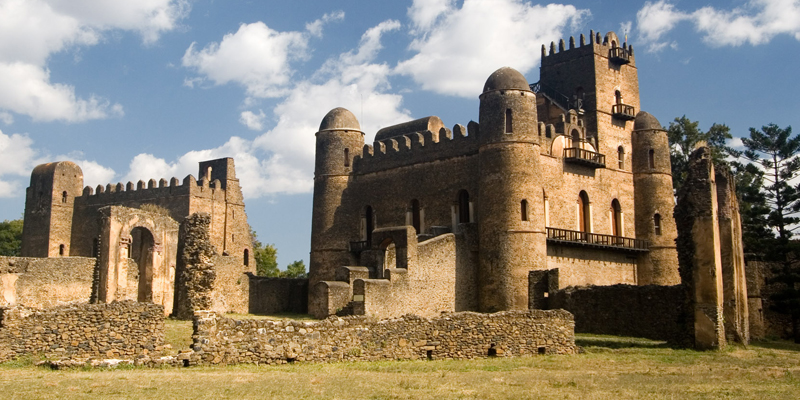
The imperial castel in Gondar.
Many Ethiopian medieval kings ruled out of Gondar and built their own beautiful castles, churches and monasteries. Some of the prominent Gondarian kings are: Fasildes, Yohanes Iyasu, David and Bekafa. Gondar became once a very powerful Christian kingdom and played a big role for the growth of Ethiopian art and literature until the end of nineteenth century, but when Emperor Teodros ll. came to power in 1855, he shifted its political center to Mekdela, which was a temporarily capital center before the establishment of Addis Ababa.
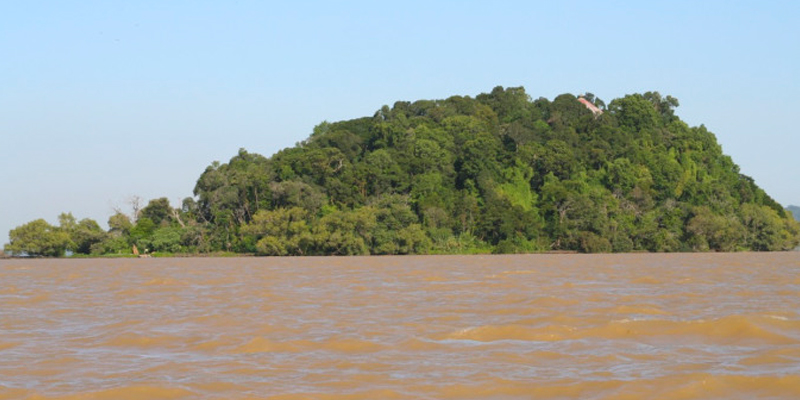
Lake Tana is Ethiopia’s first largest lake and is the source of the Blue Nile River. Located in the north-western Ethiopian Highlands, the lake is approximately 84 kilometers long and 66 kilometers wide, with a maximum depth of 15 meters, and an elevation of 1,788 meters. Its surface area ranges from 3,000 to 3,500 km, ² depending on season and rainfall. The lake was originally much larger than it is today. There are more than 30 islands on the lake and most of which are churches and monasteries. They were founded during the reign of king Amde Zion in the first half of fourteenth century. However, some of the monasteries on the islands such as Tana qirkos were used even much earleier. This island is belied to be hosting the Ark of the covenant (Ark of Moses) for about 800 years after minilik l brought from Israel before it was taken to Axum.
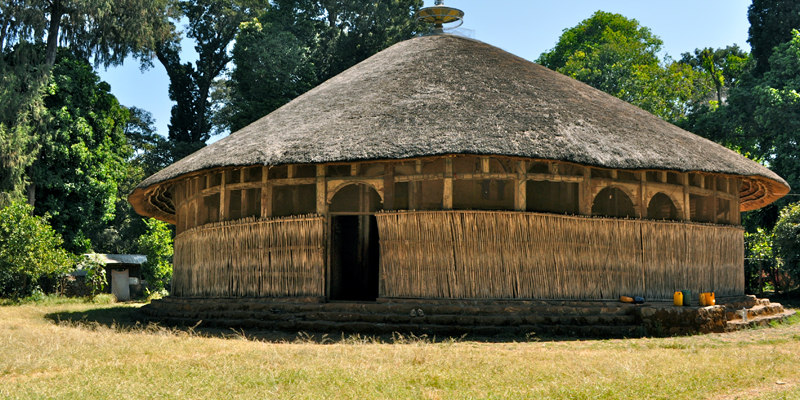
Another unique feature of this islands monasteries built after the designs of regular round houses form with conical thatched roofs and decorated the inteiror part of churche with beautiful wall paintings. These island monasteries are stuffed with percious Ethiopian treasures such as royal crowns, ancient bibles, historical art, sacred relics, including the remains of royals, etc.

The magnificent Blue Nile waterfall
The Lake was formed about 5 million years ago when lava blocked more than 60 streams and rivers. Since there are no upstream waters that link the lake to other waterways, the lake became ecologically isolated when it was obstructed, causing the evolution of the fish fauna of the lake and its tributaries to go its own independent way. As a result, 19 species of endemic fish, live in the lake.
Among the mammals, the Hippopotamus is the most eye-catching species, often seen in the wetlands of the discharge into the Blue Nile River. Obviously, numerous wetland birds, such as the great white pelican and African darter, reside at Lake Tana. It is also an important wintering ground for many migrant waterbirds. There are no crocodiles, but the African softshell turtle has been recorded near the Blue Nile outflow from the lake. There are fifteen species of molluscs, including one endemic as well as an endemic freshwater sponge.
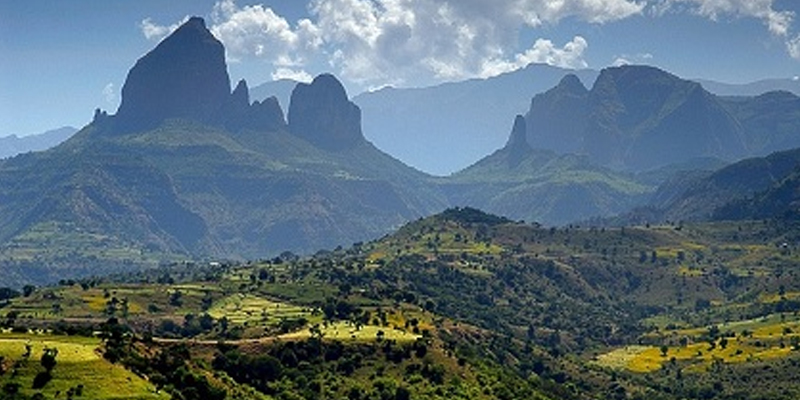
Spectacular view of the higest peak in the semien mountains national park
Semien Mountains National Park was firstly gazette in 1969 and registered in 1978 as the first Ethiopian world natural heritage and covers an area of 232 square kilometers. Due to its unique, scenery landscape and biodiversity of flora and fauna were the criteria to be register as the first Ethiopian world natural heritage. The semien mountain massif is one of the major highland of Africa rising to the highest point in Ethiopia, Ras Dejen (4560 m), which is the fourth highest peak in the continent. Although in Africa, not far from equator, snow and ice appear on the highest points, and nights temperature often fall below zero.
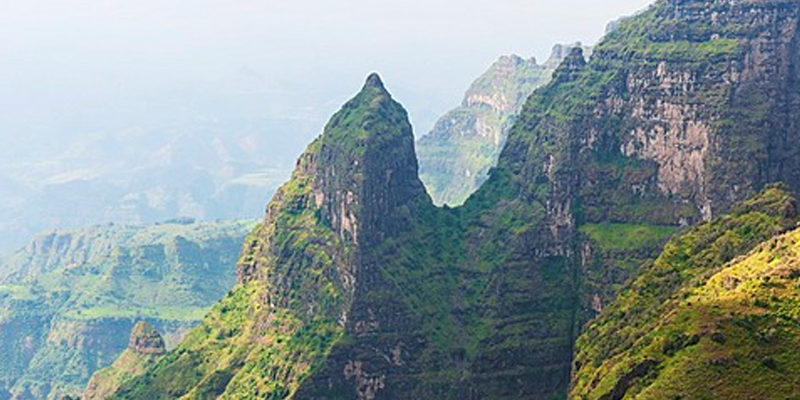
The semien mountains, north of Gondar, provide an excellent trekking area with a good infrastructure of equipment provision and guide facilities in place. This park has spectacular views and a large varieties of wildlife, including Gelada Baboons, Walia Ibex, Ethiopian wolves and birds of prey such as the rare lammergeyer, a huge vulture. The park is made up of a rocky massif, which slopes down to grassland-the massif is cut by streams and gorges. The national park has three general botanical regions. The lower slopes have been cultivated and grazed, while the alpine region (up to 3600m) are forested. The higher lands are mountain grasslands with fescue grasses as well as heather, splendid Red Hot Pokers and Giant Lobelia. The park was created primarily to protect the walia ibex, a type of wild goat, and over 1000 are said to live in the park. However, it is easy to spot a troops of Gelada Baboon in the alpine region, but rare to see the Ethiopian wolf. The Ethiopian wolf is one of the endangered mammals and only found in the Simien and Bale mountain, is rarely seen by visitor. Over 50 bird species have been reported in the Simien mountain national park.
+251918040958
historicabyssinia@gmail.com
teodrosnegesse16@gmail.com